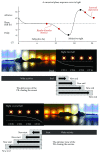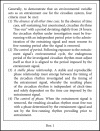Precision Light for the Treatment of Psychiatric Disorders
- PMID: 29593784
- PMCID: PMC5821959
- DOI: 10.1155/2018/5868570
Precision Light for the Treatment of Psychiatric Disorders
Abstract
Circadian timekeeping can be reset by brief flashes of light using stimulation protocols thousands of times shorter than those previously assumed to be necessary for traditional phototherapy. These observations point to a future where flexible architectures of nanosecond-, microsecond-, and millisecond-scale light pulses are compiled to reprogram the brain's internal clock when it has been altered by psychiatric illness or advanced age. In the current review, we present a chronology of seminal experiments that established the synchronizing influence of light on the human circadian system and the efficacy of prolonged bright-light exposure for reducing symptoms associated with seasonal affective disorder. We conclude with a discussion of the different ways that precision flashes could be parlayed during sleep to effect neuroadaptive changes in brain function. This article is a contribution to a special issue on Circadian Rhythms in Regulation of Brain Processes and Role in Psychiatric Disorders curated by editors Shimon Amir, Karen Gamble, Oliver Stork, and Harry Pantazopoulos.
Figures


Similar articles
-
Phototherapy for seasonal affective disorder: a blind comparison of three different schedules.Am J Psychiatry. 1994 Jul;151(7):1081-3. doi: 10.1176/ajp.151.7.1081. Am J Psychiatry. 1994. PMID: 8010369 Clinical Trial.
-
Illuminating rationale and uses for light therapy.J Clin Sleep Med. 2009 Apr 15;5(2):155-63. J Clin Sleep Med. 2009. PMID: 19968050 Free PMC article. Review.
-
The psychiatry of light.Harv Rev Psychiatry. 2015 May-Jun;23(3):188-94. doi: 10.1097/HRP.0000000000000078. Harv Rev Psychiatry. 2015. PMID: 25839643 Review.
-
The circadian rhythm of temperature during light treatment for winter depression.Biol Psychiatry. 1993 Aug 15;34(4):210-20. doi: 10.1016/0006-3223(93)90074-n. Biol Psychiatry. 1993. PMID: 8399817
-
Bright light therapy.Neuro Endocrinol Lett. 2008 Nov;29 Suppl 1:33-64. Neuro Endocrinol Lett. 2008. PMID: 19029878 Review.
Cited by
-
Circadian Responses to Light-Flash Exposure: Conceptualization and New Data Guiding Future Directions.Front Neurol. 2021 Feb 11;12:627550. doi: 10.3389/fneur.2021.627550. eCollection 2021. Front Neurol. 2021. PMID: 33643205 Free PMC article.
-
Chronobiology of limbic seizures: Potential mechanisms and prospects of chronotherapy for mesial temporal lobe epilepsy.Neurosci Biobehav Rev. 2019 Mar;98:122-134. doi: 10.1016/j.neubiorev.2019.01.004. Epub 2019 Jan 7. Neurosci Biobehav Rev. 2019. PMID: 30629979 Free PMC article. Review.
-
Why humans evolved blue eyes.Front Psychol. 2025 Apr 16;16:1442500. doi: 10.3389/fpsyg.2025.1442500. eCollection 2025. Front Psychol. 2025. PMID: 40309207 Free PMC article.
-
"Shedding Light on Light": A Review on the Effects on Mental Health of Exposure to Optical Radiation.Int J Environ Res Public Health. 2021 Feb 9;18(4):1670. doi: 10.3390/ijerph18041670. Int J Environ Res Public Health. 2021. PMID: 33572423 Free PMC article. Review.
-
The Importance of Early Identification for Parkinson's Disease Patients with Postural Instability and Gait Disturbance.Comput Intell Neurosci. 2022 Nov 18;2022:6701519. doi: 10.1155/2022/6701519. eCollection 2022. Comput Intell Neurosci. 2022. Retraction in: Comput Intell Neurosci. 2023 Nov 29;2023:9754107. doi: 10.1155/2023/9754107. PMID: 36438683 Free PMC article. Retracted.
References
-
- Daan S. The Circadian Clock. New York: Springer; 2010. A history of chronobiological concepts; pp. 1–35.
-
- Pittendrigh C. S. On temporal organization in living systems. Harvey Lectures. 1961;56:93–125. - PubMed
-
- Horton T. H. Circadian Clocks. Vol. 12. New York: K1uwer Academic/Plenum Publishers; 2001. Conceptual issues in the ecology and evolution of circadian rhythms; pp. 45–57.
Publication types
MeSH terms
LinkOut - more resources
Full Text Sources
Other Literature Sources
Medical

